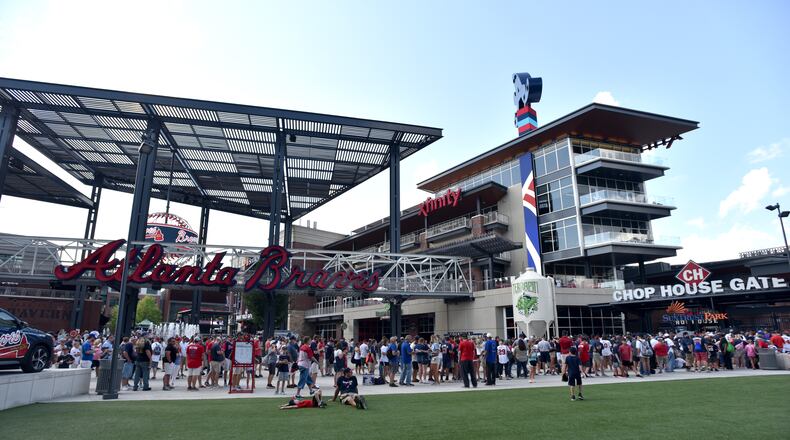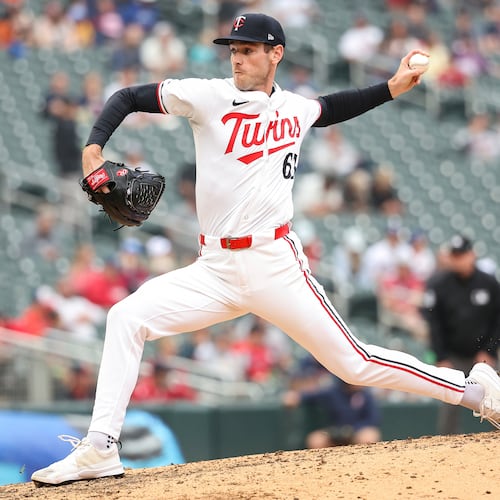The Braves open their next-to-last homestand of the regular season Tuesday night, closing in on 2 million in attendance and confident they’ll surpass the 2.5 million drawn in SunTrust Park’s inaugural season.
The nine-day homestand starts with two games against the Tampa Bay Rays, followed by one against the Chicago Cubs (a makeup of a May rainout), three against the Pittsburgh Pirates and three against the Boston Red Sox.
It’s a compelling string of games for the National League East-leading Braves: The Rays are on an eight-game winning streak; the Cubs have the NL’s best record; the Red Sox have MLB’s best record.
The Braves’ crowds often decline at this time of year, because schools are back in session and football season is getting underway. It will be interesting to see if that pattern is countered to some extent, especially over the Labor Day weekend, by the Braves’ surprising position atop their division.
Braves president and CEO Derek Schiller, who runs the business side of the operation, acknowledged the team is “susceptible” to dips in attendance early and late in the season compared to the peak mid-season months when school is out. “But overall I think we’re going to see strong attendance down the stretch … with good meaningful games,” he said.
The Braves’ attendance, defined by MLB as tickets sold, has reached 1.95 million through 62 home games, an average of 31,470 per game. That is slightly ahead of last year’s average of 31,184 at the same point.
But with 19 home games remaining, advance ticket sales for the final two homestands ensure that attendance for the full season will be higher than last year’s 2.51 million, Schiller said.
“We’ve already sold more tickets than we did last year,” he said. “We know we’re going to exceed attendance year over year … if you take into account all the tickets sold for games yet to be played.”
An overall attendance increase in the second season in a new stadium bucks an MLB trend. Teams customarily get significant attendance boosts in the first year in new stadiums, as the Braves did last season. But 12 of the other 14 MLB teams to open new stadiums since 2000 had attendance declines in the second season, giving back some of the gains of the inaugural season with an average drop of 12.5 percent.
“While we didn’t necessarily think that (would happen here), there was a chance it was going to, based upon the history of other ballparks,” Schiller said. “Lo and behold, we have a baseball team that is in first place and has some remarkable stories occurring.”
Attendance likely will continue to fluctuate considerably depending on the day of the week. On a homestand earlier this month, crowds dipped below 20,000 for three weeknight games but hit a stadium-record 42,143 for a Saturday night game.
The Braves, who rank 12th among the 30 MLB teams in attendance per game, are pleased with how fans are using technology at the ballpark.
Some 1.06 million fans, representing 54 percent of tickets sold for games played so far, have entered the stadium via tickets stored on their smartphones, according to the Braves.
The Braves have aggressively steered fans to mobile tickets, and group sales account for a significant portion of the customers not using them, Schiller said. The Braves sell considerable tickets to groups of 25 or more and issue those tickets in printed form for distribution by the company or organization buying them. Others using printed tickets tend to seek them for one reason or another, such as not having a smartphone or not being technologically comfortable with mobile tickets, Schiller said.
But the number of fans using mobile ticket entry has increased more than 25 percent from last season, he said.
On another technology metric, Schiller said an average of 18,406 fans per game utilize the stadium’s high-speed WiFi network. That is about 59 percent of the average announced attendance. WiFi usage peaked at 21,312 at a late-July game.
The Braves, who had their first off day in three weeks Monday, will play 19 of their final 32 regular-season games at home. Their last homestand, Sept. 14-23, will conclude with a four-game series against the Philadelphia Phillies, currently in second place in the NL East, three games behind the Braves.
The Braves have a 34-28 record at SunTrust Park this season, a .548 winning percentage. They have a slightly better record on the road, 39-29, a .574 winning percentage.
BRAVES’ NEXT HOMESTAND
> Vs. Tampa Bay Rays: games at 7:35 p.m. Tuesday and Wednesday
> Vs. Chicago Cubs: game at 7:35 p.m. Thursday
> Vs. Pittsburgh Pirates: games at 7:35 p.m. Friday, 7:10 p.m. Saturday and 5:05 p.m. Sunday
> Vs. Boston Red Sox: games at 1:05 p.m. Sept. 3, 7:35 p.m. Sept. 4 and 12:10 p.m. Sept. 5
NUMBERS SO FAR
Hover over the columns in chart below -- or select a group of columns -- to get details on the games and attendance. You also can filter by opponents. The red line constitutes the average attendance over the season.
About the Author
Keep Reading
The Latest
Featured




